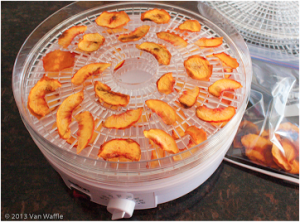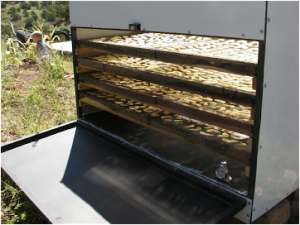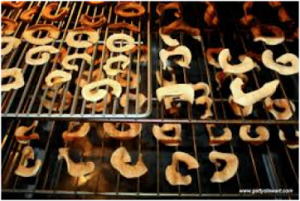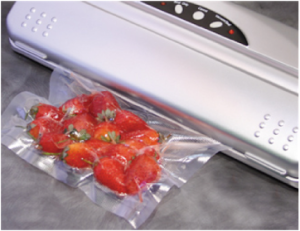Harvesting ripe fruit and berries from your orchard can often yield more than you or your family can eat all at once! A great way to prevent your harvest from rotting is to preserve it through dehydration!
Preparation
Only use fully ripened fruit, cut into pieces about 1/4 inch thick. Clean fruit thoroughly and remove all inedible parts, though peel can be left on. Discard any bruised or over-ripe fruit, as they can affect the quality of all fruit being dried. If drying berries, figs, cherries, or any fruit with a waxy coating, crack the skins by blanching—placing them in boiling water for just a few minutes and quickly rinsing them with cold tap water. This skin cracking will allow the moisture inside them to fully dehydrate and prevent molding during storage. Fruit must be placed on drying trays in a single layer. Pre-soaking in a lemon juice and water mixture can help retain color!
How quickly and effectively your fruit dries depends on your method and equipment. The conditions fruit dries best in are as follows:
Low humidity (below 60%)
Good air circulation
Consistent temperature (minimum 90 degrees, maximum 150 degrees)
Dehydrating
The fastest and most reliable way to dry fruit is through a commercial food dehydrator. Dehydrators are temperature controlled, sterile, and have adequate air-flow. Here are reviews of some common food dehydrators: kitchenchatters.com/food-dehydrator-reviews. They are the most efficient method of fruit drying and come in a range of prices and sizes. They are usually priced anywhere from $25 – $300, though they can often be found on Craigslist or in thrift stores very inexpensively. They can dry up to 15 lbs of fruit at once. They can also be used to dry veggies and make jerky!
Sun Drying
Placing your fruit in the sun is a less expensive method, but can be unreliable and take up to 3-5 days if the weather is inconsistent. Drying trays should be made of stainless steel, and netting for insect protection should be used to cover the fruit. This net also protects the food from direct sunlight, which can destroy certain enzymes. Be sure to check on your fruit to make sure it is not being scorched. A hot, breezy day with low humidity is ideal.
Solar Drying
A solar oven or solar dehydrator can be used as a quicker method of sun drying. Another, much simpler, method is to place fruit under the back window of a car with the windows open. Traditional methods of fruit preservation through drying vary from using attics to sheets and baskets hung from trees. Your method will depend on how much space and time you have. You can also Build a Solar Dehydrator!
Oven Drying
Conventional oven drying takes 2-3 times longer than a dehydrator but is much faster than sun/solar drying. The disadvantage is the energy cost of leaving the oven on for hours at a time. Turn your oven on its lowest temperature setting (150 degrees, usually), and prop the door open to allow for air circulation and moisture to escape. The oven can dry up to 6 lbs of fruit at once – suitable for single families. Drying time usually takes 5-8 hours, but varies depending on humidity, fruit slice size, and other factors.
NEVER use a microwave to dehydrate fruit. They do not provide proper ventilation and can scorch fruits very quickly.
Storage
Always allow fruit to cool completely before storage because cooling during storage can create mold. Clean, air-tight containers should be used and it’s a good idea to remove as much air as possible from your containers (sucking air from a small opened corner of a plastic bag is the simplest method; vacuum sealers are amazing for preservation, but also expensive). Pack fruit in the quantities you will likely use them in, such as one serving or one recipe’s worth. Once you open a package and expose it to the air, it degrades the storage quality. Store dried fruit in cool, dark, and dry conditions. Fruit should be eaten within a year if stored at 60 degrees F. If stored at 80 degrees, fruit must be eaten after 6 months. If stored properly, you’ll have just enough fruit to last you until your next harvest!
Sources:
http://nchfp.uga.edu/publications/uga/uga_dry_fruit.pdf
http://www.sparkpeople.com/blog/blog.asp?post=diy_turn_summers_fruit_into_natures_candy
http://nchfp.uga.edu/how/dry/pack_store.html
This edition of POP TIPS prepared by 2014 POP intern, Megan Bazin, and POP Program Director, Robyn Mello.
SUPPORT US! If you found this entry useful, informative, or inspiring, please consider a donation of any size to help POP in planting and supporting community orchards in Philadelphia: phillyorchards.org/donate.



